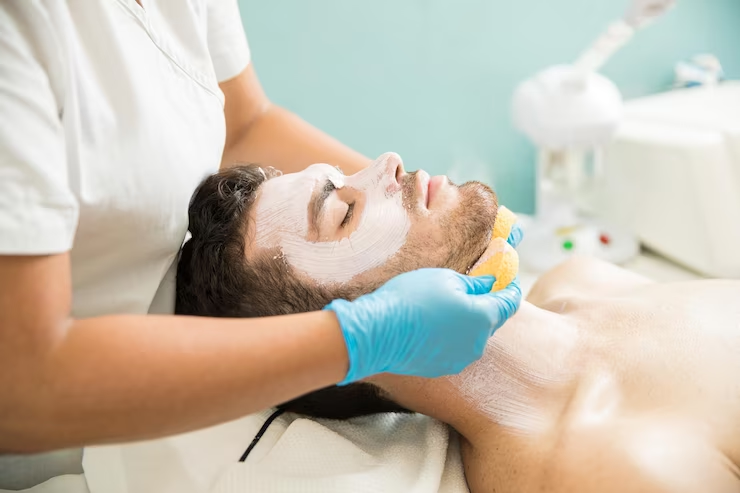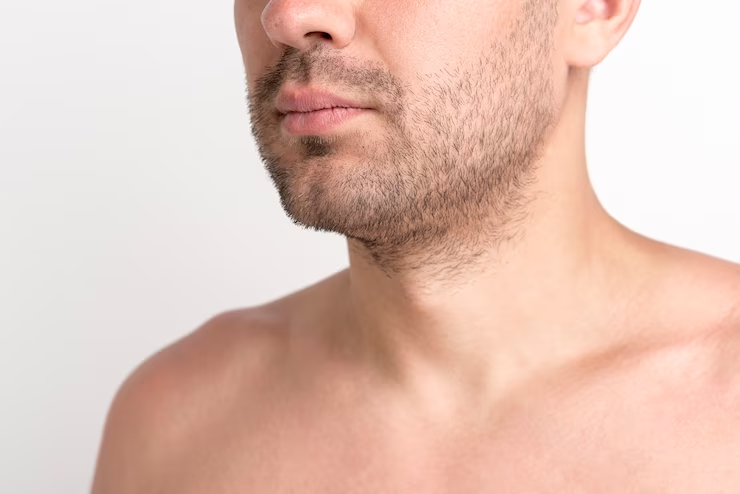
You're probably familiar with chemical peels as a way to improve your skin's texture and appearance. Chemical peel refers to application of one or more chemicals to the skin to burn off damaged skin cells. This leads to resurfacing of skin by removing the superficial layers. Chemical peels are an exfoliant that can be used on any body part, including the face. However, they're most often used to treat acne, fine lines and wrinkles, to reduce damage caused by excessive sun exposure (photoaging) and other forms of skin discoloration like freckles and melasma on the face.
Chemical peels create a controlled injury on the surface of your skin. This triggers your body's healing response to repair the damage, which results in new skin growth that's smoother and fresher-looking than before.
In this post, we'll explain the basics of chemical peels for acne—what they are, how they work, and why you should consider them for your skincare routine. So let's get started!
How Chemical Peels Work for Acne
Chemical peels are a great option for anyone who wants to reduce the appearance of blemishes and acne scars and improve their skin's texture. Chemical peels remove the outermost layer of your skin, which helps to smooth out uneven patches and reduce the visibility of acne scars.
Chemical peels also treat sun damage, age spots, fine lines and wrinkles, discoloration, and other skin conditions. Peels may stimulate new collagen formation which improves the skin texture and to reduce scars. With over-the-counter products, chemical peels can be done in a dermatologist's office or at home.
There are three main types of chemical peels: superficial (such as glycolic acid, jessner's peel and salicylic acid), medium depth (such as trichloroacetic acid) deep (such as phenol). They all work by removing damaged layers of skin so that new healthy cells can grow in their place.
Types of Chemical Peels for Acne
Light chemical peels
Light chemical peels are a great option if you're looking to give your acne-prone skin a gentle exfoliation. These peels use mild agents, like glycolic acid or salicylic acid, that don't cause much damage or inflammation but can still get rid of dead skin and make pores look smaller.

Alpha hydroxy acids
Beta hydroxy acid
Jessner's Peel
Medium depth peels
Medium-depth peels are one of the most common types of chemical peel for acne. They can improve skin texture, reduce fine lines and wrinkles, lighten acne scars, and treat skin discoloration.
Medium-depth peels include trichloroacetic acid peels or TCA peels. TCA is a strong chemical that removes the outermost skin layer, usually damaged by acne. These peels usually occur in an office or clinic setting, and an aesthetician or dermatologist typically administers them.
Deep peels
Deep peels penetrate deeper into the dermis layers and can be used to treat acne. This peel removes damaged skin tissue, which helps reduce inflammation in your pores.
One type of deep peel is laser resurfacing, which uses a laser to burn off the top layers of your skin. This can be an effective treatment for acne scarring, but it isn't recommended for people with sensitive skin or who want something less invasive.
Phenol peels
Phenol peels are the most aggressive chemical peels for acne, penetrating deeper into the skin. They're more likely to cause side effects but have the most dramatic results. Phenol can result in deep skin injury. Most dermatologists rarely use it nowadays for facial peels because of the risk of scarring and toxicity if absorption occurs through skin.
Phenol peels are often combined with resorcinol or salicylic acid to provide added benefits and reduce the chance of burning. Combining phenol and resorcinol or salicylic acid can offer an added anti-inflammatory effect that may help clear acne more quickly.
Peels can be repeated as necessary. Superficial peels can be done every few weeks. Moderate to deep peels can be repeated after 3 to 6 months.
What are the contraindications for chemical peels? Some people with certain skin types have an increased risk for pigmentation and keloid scarring. Your dermatologist will decide whether your skin is suitable for a peel.
Preparing for a Chemical Peel for Acne
Use specific products
If you are about to get a chemical peel for acne scars, preparing your skin as well as possible is essential. Your dermatologist will assess your skin type prior to a peel. If you have darker skin, lighter peels will be done because of the risk of post inflammatory pigmentation. First, make sure you're using the products recommended by your doctor. These products will help you avoid irritation and allow the chemical peel to work more effectively. Pre-treatment creams are prescribed to be applied to the face at night for several weeks. Ex: tretinoin, glycolic acid or hydroquinone
Wear sunscreen
If you're planning to get a chemical peel for acne, protecting your skin before and after the procedure is essential. Broad spectrum sunscreen of at least SPF 50 must be used during the day. Peels can make your skin more susceptible to sun damage, so taking extra care of your skin is even more important than usual.
Avoid exfoliants
Stop using facial exfoliants one week before the procedure, as this will make your skin more likely to be irritated and sensitive after the peel. This will help ensure you get the best results from your peel and reduce the chance of irritation or damage to your skin.
Avoid sun exposure
The skin can be susceptible during a chemical peel, so avoiding excessive sun exposure is important. This can help prevent hyperpigmentation and dark spots on the skin that may result from the peel and avoid the risk of skin cancer.
What to Expect During a Chemical Peel for Acne
After your face is thoroughly washed, the peeling agent is applied for several minutes. When you get a chemical peel, you should expect burning, tingling, and stinging. The degree of these symptoms depends on the depth of the chemical peel. Then the peel is neutralized which lessens the burning sensation.
For a superficial chemical peel, you'll feel mild burning or tingling for 3-5 minutes after the procedure. If you're getting a medium-depth chemical peel, the sensations can be quite intense—you may even experience stinging for up to 15-20 minutes after your treatment.
To help reduce discomfort from these symptoms, ask your doctor about numbing cream before the peel. Sometimes painkillers are prescribed and deeper peels may be done under sedation. You may also want to use icy cold clothes to reduce heat in your skin. After deeper peels antibiotics and antivirals may be prescribed.
Aftercare After Chemical Peel for Acne

Aftercare is a critical step in the recovery process after your chemical peel. Here are our top tips for chemical peel aftercare:
After your chemical peel, cleanse your skin with cool water and mild soap. Always pat your skin dry—never rub it dry, as that can irritate. Cool the treated area with cold water sprays.
Aftercare includes using a soap-free cleanser, which you should apply every time you wash your face. This will keep your skin from becoming dry, which can cause inflammation and irritation.
After your chemical peel, the skin is more sensitive to the sun. To prevent damage to your skin, you should use a high-SPF, broad-spectrum sunscreen with at least 30 SPF every time you go out in the sun.
You must avoid exfoliating for at least 3 to 5 days after your chemical peel.
This is important because you may experience irritation and sensitivity, which exfoliation can exacerbate.
Avoid saunas and prolonged sun exposure for the next 24 hours. These will increase your risk of burning, which can cause more damage to your skin than a chemical peel.
Avoid strenuous exercise for at least two weeks. This includes any exercise that makes you breathe heavily or sweat a lot. You may be able to return to normal activities once your skin has healed, but it's best to check with your doctor first.
Applying a good quality moisturizer is essential, as it will help to keep your skin hydrated and ensure that any dry patches are kept at bay.
Do not pick as it may cause scarring and poor healing.
Avoid products containing retinol for the first 14 days after your treatment. Retinol can cause the skin to become more sensitive and may increase the risk of irritation, burning, or redness.
After your chemical peel, giving your skin time to heal is essential. You should wait at least 2–3 weeks before treating your skin with other skincare products or treatments, including retinol, glycolic acid, and scrubs.
Frequently Asked Questions
__How much do chemical peels for acne cost? __Chemical peels for acne scars are a great way to get a smooth, glowing complexion without going under the knife. But how much do chemical peels cost?
A dermatologist usually does a chemical peel, which costs between $350-$800, depending on your skin type, desired results, and location. Your insurance may cover the cost of a chemical peel if it's medically necessary to treat a condition such as acne or other skin conditions.
__Can a chemical peel treat acne scars? __Yes, a chemical peel can be used to treat acne scars.
Chemical peels are a popular treatment for acne scars because they help to remove the damaged, discolored skin that can result from acne while also increasing skin regeneration and healing. Chemical peels are also effective in reducing fine lines and wrinkles.
__What are the side effects of chemical peels for acne? __The side effects of chemical peels can be mild or severe, depending on the strength of the peel and how long you leave it on your skin. The most common side effects are temporary and mild, like burning, dryness, redness, and swelling. These symptoms usually go away within a few days after the treatment. Infection, scarring and pigmentation are uncommon side effects which can occur with deeper peels.
Conclusion
In conclusion, a chemical peel is a great option for treating moderate to severe acne because it can help to reduce inflammation and improve the appearance of your skin. However, there are risks associated with this type of treatment, including scarring and discoloration.
If you do decide to go ahead with a chemical peel for acne, make sure that you follow all instructions carefully and talk to your dermatologist about any questions or concerns that you may have about the process.









